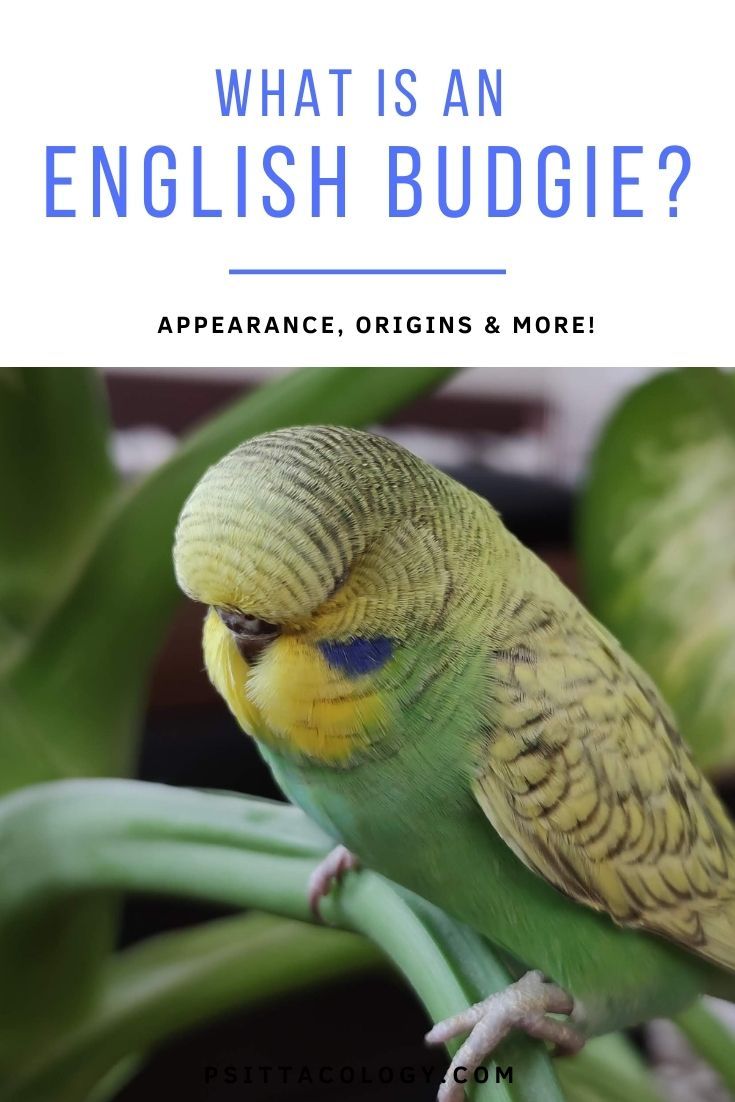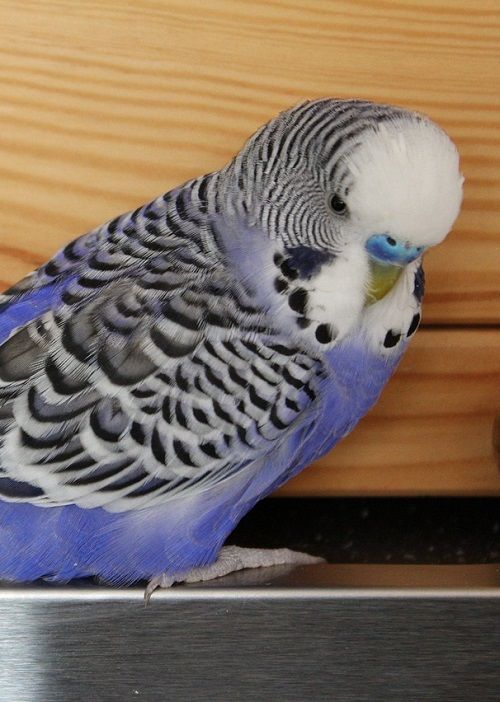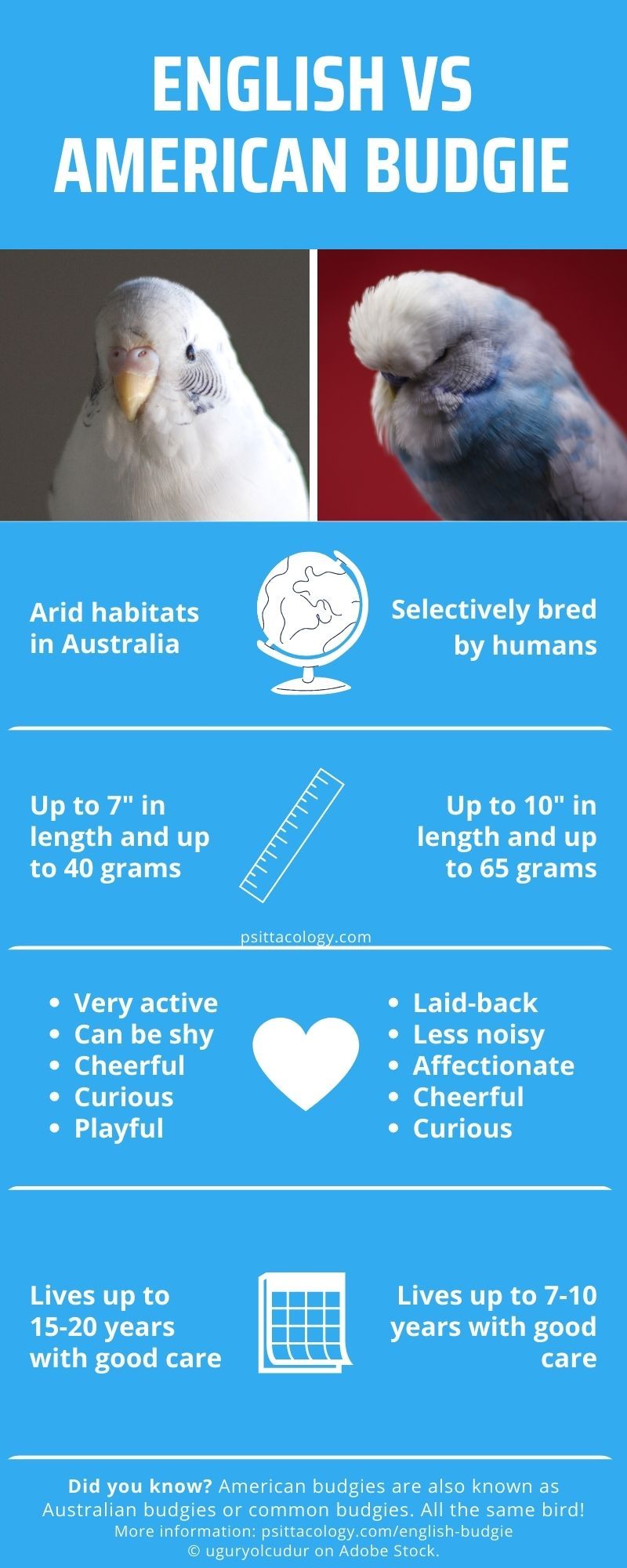Ever been at the pet store, looking at their budgies, and confused to see two different-looking types of these parakeets with a significant price difference? You wouldn’t be the first! English budgies and common budgies are very much alike, but there are also significant differences. What do you need to know? And which type should you add to your feathered family?
Keep reading for everything you need to know about English budgies, how they differ from other budgies and how to find out which is better for you!
English budgie origins & history
Where did the English budgerigar come from, and how did it end up looking so different from other budgies? Well, their origins are the same. Budgies (Melopsittacus undulatus) are naturally found in Australia’s arid inland areas.
Unsurprisingly, Aboriginal nations discovered budgies long before Westerners did. They valued them as a source of food and these little parrots held a strong cultural significance to some nations.
The species was first scientifically described in the West in 1805, and by 1850, they were all the rage in England and beyond. Breeders first managed to produce different colors a decade or two after that, and it all spiraled from there. These little parrots never did lose their popularity.
Selective breeding produced all sorts of funky mutations in budgies. There are more different colors than I’m even going to try to describe here, and there are also crested budgies with a funny hairstyle, as well as the expensive helicopter budgie. And, of course: the English budgie!
Most sources suggest the English variety, which is also known as ‘exhibition budgie’, began to pop up around the 1840s. As the ‘exhibition’ denomination suggests, it’s a mutation popular at bird shows. You’ll recognize it by its large forehead (which partially covers the eyes), hefty body and large throat spots.

Do English budgies make good pets?
So, the English budgie is a selectively bred variety of the common (also known as Australian or American) budgie. They’re popular for showing, but are worth their price tag if you’re looking for a pet? Many budgie enthusiasts say yes.
Breeders have been selecting English budgie stock specifically for shows for likely more than 180 years now. They breed not just for color and appearance, but also for personality, which has resulted in a bird that’s a lot better at sitting still than the average common budgie. After all, it’s difficult for a judge to score a bird on a range of different points if it’s bouncing across its cage!
English budgies are considered affectionate, social, easy to train and relatively quiet (as far as parrots go). They make great pets if you’re looking for a little animal that will really integrate into your family. Child-safe, they won’t bite unless they’re very scared, and even then their nips won’t do much damage.
Tip: English budgie care is identical to regular budgie care. So if you’re interested in adding one to your family, be sure to head over to the full budgie care guide to find out what your new bird will need to thrive.
Can English budgies talk?
Yes, English budgies can absolutely talk. Budgies in general are fantastic talkers; their voices are a little robotic, but they can pick up mind-boggling vocabularies. The only thing you need to keep in mind is that because English budgies tend to be a bit quieter than the common variety, you may not actually hear them speaking as often.
If you’d like to know more about how to train these little parrots to talk, have a look at the article on parakeet talking.

American vs English budgie
For those still unsure whether to go for an American or English budgie, let’s have a look at the differences and similarities. Are they really that different?
Can English and American budgies breed?
Yes, absolutely. Both varieties are still the same species, Melopsittacus undulatus. In fact, I’ve seen plenty of budgies that were clearly a mix. If you just can’t manage to choose between the two, tracking down one of those might actually be the ideal solution for you!
Differences in appearance
As you can see in the infographic below, there are definitely differences in appearance between American vs English budgie. It’s clear they’re the same species, but breeders very much went in a different direction with the English variety.
A few of the main differences include:
- At a maximum total length of around 10″, English budgies are significantly longer than the 7″ common budgie.
- They are also heavier at a maximum weight of 65 grams, versus their diminutive cousins at no more than 40 grams.
- English budgies sport a large, fluffy forehead that partially obscures the eyes.
- They also have long, fluffy cheek feathers that partially obscure the beak.
- If they have cheek/throat patches, those are significantly bigger than in common budgies.
- Due to being bred for showing, English budgies’ colors and patterns are clean and bright.
Differences in personality
Although there are some general differences in American vs English budgie behavior, you should keep in mind that it all comes down to the individual in the end. It’s completely possible to end up with a common budgie that acts like the average English, or the other way round.
English budgies are still definitely budgies. They’re curious, extremely social and flock-oriented. The species is not prone to aggression at all and is just a great, cheerful bird to have around.
The English variety stands out in the following aspects:
- It tends to be calmer than American budgies, which are real pocket rockets.
- It’s usually quieter, with a softer and lower voice*. American budgies, especially the males, truly spend ALL DAY chattering.
- It seems to warm a little more easily to human contact.
*Don’t let this fool you into thinking it’s the perfect ‘quiet parrot’, though. They all make noise.

Differences in health & lifespan
With extensive selective breeding of any animal can come issues, and the English budgie is no exception. Inbreeding is not uncommon when trying to achieve certain visual traits, and it can unfortunately weaken the resulting offspring.
A good breeder won’t allow budgies with problems to reproduce, but certain issues don’t pop up until later or go completely unnoticed.
What I’m trying to say is… English budgies are more prone to health issues. They don’t suffer any disease in particular, instead appearing more susceptible to all the normal problems (crop infections, lung problems, sudden illness). Their lifespan is also shorter than that of a normal budgie.
Even with great care, most English budgies don’t make it past 10, while 15-20 isn’t all too uncommon for American ones. You can read more about this in the article on budgie lifespan.
If you do want an English budgie, this is definitely something to consider. Some parrot enthusiasts avoid them for exactly this reason, stating that breeding birds solely for looks instead of health causes more trouble and suffering than it’s worth.
Differences in price
Prices for birds are obviously different in every area. Here in Spain, I’ve seen common budgies of questionable origins sold for as little as €10 and English ones for €35. That would be about double for birds from a responsible breeder.
You can likely expect to pay $15-25 in the United States for a pet store common budgie. An English budgie can fetch up to $100 depending on the color variety.
Frequently asked questions
Yes, they are still the same species. The offspring will be somewhere in between.
No, talking ability in budgies is a highly individual thing! Males and birds that have been exposed to humans from an early age are more likely to talk.
Yes, a well-socialized English budgie will make a wonderful and friendly pet.
If you have any more questions about English budgies, their care or how they differ from common budgies, or if you’d like to share your own experience with these wonderful little parakeets, don’t hesitate to leave a comment below!
Budgerigars: Australia’s colourful, clever and much-loved avian gift to the world

I didn’t see the word “parakeet“ in any of the information you provided. Is there a difference between a parakeet and a budgie? Or, is a parakeet another name for the American budgie?
Parakeet is a name for any budgie – they’re also known as the common parakeet. However, in articles exclusively dedicated to budgies, I refer to them as budgies or budgerigars most of the time, because there are many other parakeet species out there. Hope that makes sense 🙂
Is it possible I have a half breed bro and sis as they are meant to be but are not “floofy” as called these days. Their eyes and Beak are not obscured but the male has a bigger head and chops than his sister. I didn’t pay extra or seek them out and really couldn’t care but does this make them a mix or does this just happen sometimes? They are big and they have mash up tails sadly. Is this signs of inbreeding please?
If you don’t know the parents, then it’s very much possible that only one parent was an English, and correct me if I’m wrong but I als othink it’s possible that the boy inherited more of the English genes than his sister. As for the tails, what’s the cage situation like? The feathers can become damaged if they’re in a small cage or climb around a lot.
I think it is so cruel to keep any bird locked up in a cage it should be illegal. And anyone who has birds in cages should hang there heads in shame.
That’s why here at Psittacology, we advocate for an open cage policy 🙂 and also for adopting rather than shopping.
I was given 2 young budgies on 12/30/22 by someone who didn’t want to keep them. I was told they’re English but don’t show any features you described. Bit seem to be female with now settled pink ceres. Extremely affectionate with each other, kissing, chittering, flitting about, all day til after dark. They don’t much care for people since they have each other stay as far away from my hand as possible. Is it ok to keep them together?
Hi! Yes, it’s OK to keep them together; I would personally never keep budgies alone again, they’re clearly made to be in the company of their own kind. The characteristics described here apply to tamed English budgies, untame ones will always be quite skittish. You can absolutely tame them while they’re together. You might find this article and this article helpful. Hope that helps!
PS: pink ceres mean they’re boys. You can find more details in the post on sexing a parakeet. 🙂